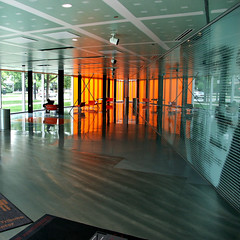Desire lines generally refer to worn paths where people naturally walk – the beaten path that trails off the sidewalk, usually as a shortcut to a destination – but can be applied more broadly to any signs or traces of user activity in an object or environment. The implicit claim of desire lines is that they represent an unbiased indication of how an object or environment is actually used by people.
My grandfather introduced me to desire lines, but he didn’t
call them by name. I can’t be sure that he knew what they were called. We were
crossing the Quad at the University of Washington, cherry trees in bloom, and
he pointed out the gentle ruts in the grass left by renegade feet in oblique
purpose to the University’s imposed paths.
“Those are the paths they should pave,” he said, pointing
out the bald earth. I think of him now whenever I see a transgressive groove
slice through the corners of trim, paved plaza geometries.
Desire lines.
Rem Koolhaas oriented his IIT Student Center around the
desire lines that students wore into the wasteland beneath the El tracks on
their passage to class, long before the building was sited. In the belly of his building there’s a placard that
maps the original paths so you can see at a macro level what you experience when
you walk through the structure: his building breathes with a unique kind of
respiration because it is so well-aligned with the passage of people through
that place. It doesn’t obstruct their passage from point A to B: It shelters
it.
I’m surprised that I’ve only just discovered this name for the
thing. It startled me when I stumbled across it yesterday, and left me to
wonder if maybe I knew it before but didn’t notice it; am noticing it now only because
of these first tentative steps off my trim path; this early attempt
at letting my feet find the way they would prefer to go.







1 comment:
Ms. Hoo, this post reminded me of The Oval on the CSU campus in Ft. Collins. The space was designed with four wide, flat concrete paths bisecting the green expanse of grass in the middle of the oval-shaped and large tree-ringed center of the old campus. Decades of walkers and bikers had worn a diagonal path (now I know it was a decision line) through the grass, off the sidewalk, from one side of the oval to the other. Eventually that path was paved with concrete also, as if the “powers that be” conceded to the will of the masses for a shortcut through the beautifully-designed (but impractical) common area. The additional pavement ruined the aesthetics of the original symmetrical pathways for me. However, I also saw The Oval as a graphic reminder of how progress and The Will of the People frequently determines direction, with beauty and art be damned.
Post a Comment